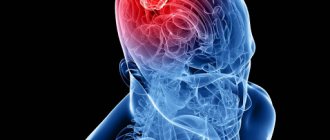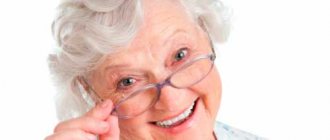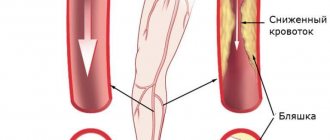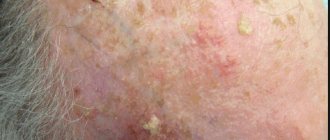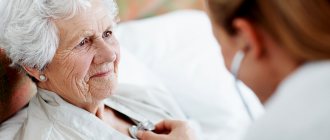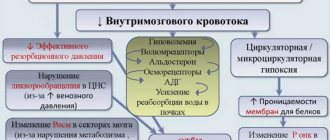28.06.2019
Stroke is an acute disorder of cerebral circulation due to blockage of blood vessels or their rupture. After a vascular accident, neurological symptoms develop within a few minutes or hours, which progress, sometimes leading to death. Recently, cases of stroke have become more frequent at young ages, up to 30 years.
What is a stroke, its types
A stroke is a disorder of cerebral circulation leading to brain damage.
The pathology is widespread. In the Russian Federation alone, there are 3 cases of stroke per 1000 inhabitants. In the post-mortem extract, it is listed as the cause of death in 23.5% of people.
Even if patients do not die after suffering a vascular accident, more than 80% of them remain disabled. Often neurological disorders are so severe that the patient is unable to care for himself. Stroke is the third leading cause of death.
There are 2 types of stroke: ischemic and hemorrhagic. The mechanism of their development and the features of treatment have nothing to do with each other. There is also a special type of hemorrhagic vascular damage - subarachnoid hemorrhage.
Ischemic
Ischemic stroke is a cerebral circulatory disorder accompanied by an acute onset. Pathology develops due to disruption or complete cessation of blood supply to the brain. This leads to softening of its tissues and infarction of the affected area. It is cerebral vascular ischemia that is one of the main causes of death worldwide. Such a stroke occurs 6 times more often than hemorrhagic lesions.
It can be of 2 types:
- Thrombotic . Develops due to blockage of blood vessels in the brain by a blood clot.
- Embolic . Occurs when blood vessels located far from the brain become blocked. The most common source of embolism is the heart muscle (cardioembolic stroke).
In 80% of cases, the pathological focus is localized in the middle cerebral artery. Other vessels account for the remaining 20%.
Reasons that can provoke ischemic damage to cerebral arteries and veins:
- Myocardial infarction.
- High or low blood pressure.
- Atrial fibrillation.
- Diabetes.
- Lipid metabolism disorders.
Risk factors include: old age, hereditary predisposition to vascular accidents, as well as lifestyle features.
Symptoms of ischemic stroke do not increase as quickly as symptoms of hemorrhagic brain damage.
Its manifestations:
- Drowsiness, dazedness.
- Brief fainting.
- Headache, dizziness.
- Nausea and vomiting.
- Pain in the eyes that gets worse with movement.
- Cramps.
- Sweating, hot flashes, dry mouth.
Depending on which part of the brain is affected, the neurological manifestations of ischemia differ. The lower and upper extremities are affected to a greater or lesser extent, paresis of the tongue and face is observed, and visual and/or auditory function deteriorates.
Hemorrhagic
Hemorrhagic stroke is bleeding into the cranial cavity. The most common cause of blood vessel rupture is high blood pressure.
Other provoking factors include:
- Aneurysm.
- Malformation of cerebral vessels.
- Vasculitis.
- Systemic connective tissue diseases.
- Taking certain medications.
- Amyloid angiopathy.
The onset of the pathology is acute; most often the manifestation occurs against the background of high blood pressure. A person experiences severe headaches, dizziness, accompanied by vomiting or nausea. This state is quickly replaced by stupor, loss of consciousness, and even the development of coma. Convulsions are possible.
Neurological symptoms manifest themselves in the form of memory loss, deterioration of sensitivity and speech function. One side of the body, which is on the opposite side of the lesion, loses the ability to function normally. This applies not only to the muscles of the torso, but also to the face.
A stroke with blood escaping into the ventricles of the brain is difficult to endure. The victim develops symptoms of meningitis and has seizures. He quickly loses consciousness.
The next 3 weeks after a stroke are considered the most difficult. At this time, cerebral edema progresses. It is he who is the main cause of death of patients. Starting from the fourth week, in surviving people, the symptoms of the lesion begin to reverse. From this time on, the severity of brain damage can be assessed. They are used to determine what degree of disability to assign to the victim.
Subarachnoid hemorrhage
Subarachnoid hemorrhage is understood as a condition that develops as a result of a breakthrough of blood vessels into the subarachnoid space of the brain. This pathology is a type of hemorrhagic stroke.
The subarachnoid space contains cerebrospinal fluid, the volume of which increases due to blood flow. The patient's intracranial pressure increases and meningitis of aseptic nature develops. The situation is aggravated by the reaction of cerebral vessels. They spasm, which leads to ischemia of the affected areas. The patient develops an ischemic stroke or transient ischemic attack.
The following reasons lead to hemorrhage into the subarachnoid space::
- Traumatic brain injuries with damage to the integrity of blood vessels.
- Aneurysm rupture.
- Dissection of the carotid or vertebral artery.
- Myxoma of the heart.
- A brain tumor.
- Amyloidosis.
- Diseases associated with blood clotting disorders.
- Uncontrolled use of anticoagulants.
The pathology manifests itself as a severe headache. Possible loss of consciousness. In parallel, symptoms of meningitis develop, with neck stiffness, vomiting, and photophobia. A distinctive sign is an increase in body temperature. In severe cases, there is a disorder of respiratory function and cardiac activity. With prolonged fainting and coma, one may suspect that blood has entered the ventricles of the brain. This occurs during its massive outpouring and threatens with serious consequences.
FAQ
How is a stroke different from a heart attack?
Cerebral infarction is one of the types of stroke and it is ischemic in nature, i.e. accompanied by a cessation of blood flow to the brain. A characteristic feature is the gradual development of the clinical picture and the predominance of focal symptoms: disturbances in speech, vision, gait, movements up to paralysis, sensitivity.
Can a stroke and heart attack happen at the same time?
If we consider only the brain, mixed stroke occurs, when the causes of stroke include both hemorrhage and ischemia. They can occur simultaneously when a vessel ruptures in one area and blood flow stops in another. Also, ischemia can develop at the site of subarachnoid hemorrhage after some time.
If we consider a heart attack as a heart disease, then these conditions can also be diagnosed simultaneously. Moreover, a stroke can develop as a result of a heart attack: the functioning of the heart suffers, and insufficient blood flows to the brain. This is how we get a stroke.
Does a stroke only occur in the brain?
Stroke (Latin insultus “swoop, attack, blow”) is an acute disruption of the blood supply to the brain due to ischemia (infarction) or hemorrhage. If ischemia occurs in other organs, it is also called a heart attack. For example, myocardial infarction, intestinal, kidney, etc. It is characterized by severe pain, dysfunction of the affected organ and other symptoms.
Does stroke occur with normal or low blood pressure?
Arterial hypertension is one of the main, but not the only causes of stroke. Thrombosis, atherosclerosis, and diabetes mellitus, in which blood pressure is normal or even reduced, are also risk factors. In addition, with low pressure, the brain is not sufficiently supplied with oxygen, which is a prerequisite for the development of ischemic stroke.
Do children have strokes?
Stroke is also diagnosed in children. It can develop even in the perinatal period. Causes: abnormalities in the coagulation system, pathologies of the cardiovascular system, including vascular malformations, bad habits of the mother during pregnancy, oxygen starvation during childbirth, trauma.
In the perinatal period and up to one year, the disease is accompanied by anxiety, frequent crying, loss of appetite, impaired reflexes in the newborn period, strabismus, and convulsions. The diagnosis is made based on an examination by a pediatric neurologist, ultrasound of the brain, and tomography results. At older ages, symptoms are similar to those of stroke in adults.
The child's body is more flexible and responds more quickly to therapy. The main thing is to diagnose a stroke in time and begin treatment.
Can a stroke go away on its own?
There is such a condition - transient stroke. It is accompanied by a short-term circulatory disorder, but no irreversible changes in brain tissue occur. The external manifestations of such a stroke are the same as a normal one, but less pronounced: headache, dizziness, darkening of the eyes, changes in sensitivity in various parts of the body. And they pass within 24 hours. However, the condition requires qualified treatment and rehabilitation, elimination of risk factors, because in the future there is a possibility of a secondary stroke.
At what pressure can a stroke occur?
A stroke can develop at any pressure. Arterial hypertension causes hemorrhagic stroke, hypotension causes ischemic stroke.
Do pine cones help prevent stroke?
Pine cones lower blood pressure, so they should not be consumed if you have hypotension. The effect is due to the tannins contained in the buds. The composition also contains vitamins C and P - they strengthen the walls of blood vessels and improve blood circulation.
The advisability of using products based on herbal raw materials is decided by the attending physician after a detailed examination. In general, pine cones for stroke can only be used as a complementary method.
Signs and symptoms of stroke
A stroke manifests unexpectedly for a person, although sometimes it is preceded by certain symptoms. If you interpret them correctly, you can avoid a terrible vascular catastrophe.
Warning signs of an impending stroke include:
- Prolonged headaches. They do not have a clear localization. It is not possible to cope with them with the help of analgesics.
- Dizziness. It occurs at rest and can intensify when performing any actions.
- Ringing in the ears.
- Sudden attack of atrial fibrillation.
- Difficulty swallowing food.
- Memory impairment.
- Numbness of arms and legs.
- Loss of coordination.
- Insomnia.
- Increased fatigue.
- Decreased overall performance.
- Rapid heartbeat and constant thirst.
The listed signs may have varying intensities. You should not ignore them; you should consult a doctor.
Symptoms of ischemic stroke increase slowly. With hemorrhagic brain damage, the clinical picture unfolds rapidly.
You can suspect a brain catastrophe based on the following symptoms::
- General cerebral symptoms . The patient experiences unbearable headaches. Nausea ends with vomiting. Consciousness is impaired, and both stupefaction and coma may occur.
- Focal symptoms . They directly depend on where exactly the lesion is localized. The patient may have decreased or completely lost muscle strength on one side of the body. Half of the face is paralyzed, causing it to become distorted. The corner of the mouth lowers, the nasolabial fold smoothes out. On the same side, the sensitivity of the arms and legs decreases. The victim’s speech deteriorates and he has difficulty oriented in space.
- Epileptiform symptoms . Sometimes a stroke provokes an epileptic attack. The patient loses consciousness, has convulsions, and foam appears at the mouth. The pupil does not react to the light beam; on the side of the lesion it is dilated. The eyes move right and left.
- Other symptoms . The patient's breathing quickens and the depth of inspiration decreases. A significant decrease in blood pressure and increased heart rate are possible. Often a stroke is accompanied by uncontrolled urination and defecation.
When the first signs of a stroke appear, you should not hesitate to call an ambulance.
There are two types of stroke:
Ischemic – blood vessels in the neck or brain become blocked. More common, it can be triggered by thrombosis, embolism, or arterial stenosis. More often it occurs at night, while clarity of consciousness is maintained. With a mini-stroke, the blockage of blood flow is temporary, but the condition also requires immediate hospitalization.
Hemorrhagic (intracerebral) - occurs in 10-15% of cases, but 30-60% of them end in death. The blood vessel ruptures completely, allowing blood to flow into the brain. Often a stroke is provoked by an aneurysm, in less than 1% of cases - by an arteriovenous malformation (usually congenital). This type of stroke usually occurs during the day, as a result of excessive physical or emotional stress.
Diagnostic methods
It is important to quickly distinguish a stroke from other diseases that can lead to the development of similar symptoms. It is almost impossible to do this on your own, as well as to determine the type of vascular accident.
The main difference between an ischemic stroke is a gradual increase in symptoms that do not lead to loss of consciousness. With hemorrhagic hemorrhage, the patient passes out quickly. However, stroke does not always have a classic course. The disease may begin and progress atypically.
Diagnosis begins with examination of the patient. The doctor collects anamnesis and determines the presence of chronic diseases. Most often, you can get information not from the victim himself, but from his relatives. The doctor performs an ECG, determines the heart rate, takes a blood test, and measures blood pressure.
It is possible to make the correct diagnosis and obtain maximum information about the patient’s condition thanks to instrumental diagnostic methods. The best option is a CT scan of the brain. Performing an MRI is difficult because the procedure takes a long time. It takes about an hour. It is impossible to spend this amount of time diagnosing an acute stroke.
Computed tomography allows you to clarify the type of pathology, where it is concentrated, to understand how badly the brain is damaged, whether the ventricles are affected, etc. The main problem is that it is not always possible to perform a CT scan in the shortest possible time. In this case, doctors have to focus on the symptoms of the disease.
To determine the source of the stroke, the method of diffusion-weighted tomography (DWI) is used. The information will be received within a few minutes.
Other examination methods include:
- Lumbar puncture.
- Cerebral angiography.
- Magnetic resonance angiography. It is performed without the introduction of a contrast agent.
- Doppler ultrasound.
Once the diagnosis is made, the doctor will immediately begin treatment.
The benefits of a boarding house for an elderly patient
Caring for an older person who has had a stroke can be difficult. In order to correctly and effectively help a patient recover, you need to have the necessary knowledge and undergo training. Not every loved one has enough strength, knowledge and time to provide quality assistance to their relative.
Caring for the patient requires monitoring medications, maintaining sleep and eating habits, maintaining regular hygiene, performing physical and cognitive rehabilitation exercises, and observing the prevention of bedsores.
At home, it is difficult to provide full-fledged, high-quality rehabilitation after a stroke. A good option is to go to a boarding house for the elderly, where the person will be surrounded by professional care, and help the relative together with specialists. He needs the support and participation of his loved ones - this is very important for a quick and successful recovery.
Who is at risk
There are people who need to be especially wary of developing a stroke, as they are at risk.
Among them:
- Persons with hypertension.
- Patients with diabetes.
- Men and women over 65 years of age.
- People with abdominal obesity.
- Persons with a hereditary predisposition to vascular pathologies.
- Patients who have previously had a stroke or heart attack.
- Patients with diagnosed atherosclerosis.
- Women over 35 years of age taking oral contraceptives.
- Smokers.
- People suffering from heart rhythm disturbances.
- People with high cholesterol levels.
Most often, patients with the listed diagnoses are registered at the dispensary. Special mention should be made of people living in a state of chronic stress. Emotional stress negatively affects all systems of the body and can cause a stroke.
Advantages of treatment at the clinic of JSC "Medicine"
On the basis of a multidisciplinary medical center (academician Roitberg’s clinic) there is a cardiac rehabilitation center specially created for the treatment of strokes. How does IB differ from a regular neurological or therapeutic department:
- specializes in the treatment of patients with stroke, its staff is trained to care for this group of patients;
- the necessary diagnostic facilities - from computer and magnetic resonance imaging scanners to a laboratory with round-the-clock operation, an intensive care unit;
- work according to local protocols developed on the basis of domestic and international principles of stroke treatment;
- early mobilization and intensive rehabilitation.
multidisciplinary team:
- vascular neurologists;
- nurses are trained to care for stroke patients;
- rehabilitators who help restore physical capabilities and self-care skills;
- speech therapists – restore the ability to oral and written communication, correct swallowing disorders;
- neuropsychologists - working to restore cognitive functions.
In addition, in the cardiac rehabilitation center there is a constant opportunity to consult with doctors of various specialties: cardiologist, neurosurgeon, psychiatrist, urologist, endocrinologist, etc. In developed countries, hospitalization in stroke units has become the “gold standard”. In the UK and Germany, 9 out of 10 patients with stroke are treated in an IB, in Poland - 8 out of 10.
How to provide first aid for a stroke
There is a clear algorithm for providing first aid to a person suffering from a stroke :
- Call a medical team . To do this, you need to dial 103 from a landline phone. If you happen to have a smartphone at hand, then the call is made to the single number 112. The doctor must immediately be informed that the person is unwell and there is a suspicion of a stroke.
- The victim must be laid on a flat surface so that his head is higher than his body. They take off his glasses and remove his lenses. If possible, you need to help him get removable dentures.
- If there is no consciousness, then you need to open the patient’s mouth slightly and turn his head to the side . This is done to prevent aspiration of vomit. It is imperative to listen to the patient’s breathing.
- For better access to fresh air, it is recommended to open a window or vent..
- Before the arrival of the medical team, it is necessary to prepare documents, if any..
Doctors need to be informed about the person’s illnesses, as well as what medications he is taking. It is prohibited to give the victim any medications. Medication correction should be carried out by emergency physicians. You should not try to give water or food to a person. This may make the situation worse.
If the patient falls and has an epileptic attack, there is no need to unclench his teeth or try to hold him. It is necessary to protect the victim from injury. To do this, place a soft object, such as a pillow, under his head. If a stroke with an epileptic attack happened on the street, then you can use a jacket or other suitable thing. Foam flowing from the mouth is wiped away with a cloth. The head should be elevated at all times.
There is no need to try to bring a person to his senses with ammonia. Until the end of the attack, it should not be moved from place to place.
If breathing stops, resuscitation measures must be started immediately. To do this, perform a heart massage and breathe mouth to mouth or mouth to nose.
Stroke test
There is a test called BE FAST, which is used in medicine to instantly diagnose a stroke attack. The abbreviation has its own meaning:
- B - balance. You need to watch how a person makes movements. Poor balance indicates an impending blow.
- E - eyes. Check the level of visual acuity - have the patient alternately close/open his eyes and tell what he sees in front of him.
- F - face. Ask to smile and stick out your tongue. During an attack, curvature occurs in one direction.
- A - arms. Have the victim raise both arms or shake their palms - one of the limbs will be weaker or will not rise.
- S - speech. Talk to the victim - if there is a lack of cerebral blood supply, speech is impaired.
- T - time. The patient denies the disorder.
If you discover at least one type of deviation, immediately contact the Yusupov Clinic, where experienced doctors will provide primary medical care, establish an accurate diagnosis, and prescribe therapeutic measures. For this purpose, innovative medical technologies of the European level, powerful equipment, and an individual approach are used. You can ask questions and get tested by calling the numbers provided.
Treatment and rehabilitation
The patient receives treatment in a hospital. All patients with suspected stroke are hospitalized on an emergency basis. The optimal period for providing medical care is the first 3 hours after a brain accident has occurred. The person is placed in the intensive care unit of a neurological hospital. After the acute period has been overcome, he is transferred to the early rehabilitation unit.
Until the diagnosis is established, basic therapy is carried out. The patient’s blood pressure is adjusted, the heart rate is normalized, and the required blood pH level is maintained. To reduce cerebral edema, diuretics and corticosteroids are prescribed. Craniotomy is possible to reduce the degree of compression. If necessary, the patient is connected to an artificial respiration apparatus.
Be sure to direct efforts to eliminate the symptoms of stroke and alleviate the patient’s condition. He is prescribed medications to lower body temperature, anticonvulsants, and antiemetics. Medicines that have a neuroprotective effect are used.
Pathogenetic therapy is based on the type of stroke. In case of ischemic brain damage, it is necessary to restore nutrition to the affected area as quickly as possible. To do this, the patient is prescribed drugs that resolve blood clots. It is possible to remove them mechanically. When thrombolysis fails, the patient is prescribed Acetylsalicylic acid and vasoactive drugs.
In case of a stroke, it is extremely important to provide timely treatment to the damaged areas of the brain. A course of use of the drug accelerates the process of recovery of brain cells after a stroke, even in cases of impaired blood circulation or hypoxia. This allows for rapid restoration of memory, thinking, speech, swallowing reflex and restoration of other functions of daily activities. Gliatilin has a positive effect on the transmission of nerve impulses, protects brain cells from repeated damage, which prevents the risk of recurrent stroke.
The drug is well tolerated by patients; it is contraindicated for use by pregnant, lactating women and people with hypersensitivity to choline alfoscerate.
Courses will need to be taken regularly. You definitely need to do physical therapy, undergo physical therapy, and visit a massage therapist. After a stroke, many patients have to restore motor skills over a long period of time and learn to care for themselves independently.
Relatives and friends should provide support to the patient and not leave him alone with the problem. Psychologists are involved in the work. Sessions with a speech therapist are often required.
Cost of initial appointment, research, treatment
It is advisable to talk about the price of the initial appointment during a preventive examination, when there is no stroke as such, but the person has pathologies that increase the risk of its development. The cost of diagnostic procedures for stroke can be found in the corresponding table, but it must be taken into account that many studies are used repeatedly to monitor the treatment process.
It is quite difficult to determine even the approximate cost of stroke treatment in Moscow. Much depends on the type of stroke, the extent of brain damage, the patient's condition, the timeliness of medical care and other important factors. In any case, the cost of medical services will be justified - after all, we are talking about preserving life.
Treatment of patients in specialized stroke departments, cardiology centers - stroke units (IB) - reduces mortality and disability by 20%, reduces financial costs at all stages of treatment.
Possible consequences, complications
The main danger of a stroke is death. If a person survives, the disease will still make itself felt with certain complications.
Early consequences include:
- Brain swelling.
- Coma.
- Pneumonia.
- Paralysis. It can be partial or complete. Most often, one half of the body is affected.
- Repeated stroke.
- Bedsores.
- Mental disorders. They can manifest themselves in moodiness, irritability, aggression, and anxiety. Sometimes dementia develops.
- Sleep disorders.
- Myocardial infarction, gastric ulcer. These disorders develop against the background of increased levels of stress hormones.
After an ischemic stroke, death occurs in 15-25% of cases. Hemorrhagic damage to the blood vessels of the brain leads to the death of 50-60% of patients. The cause of death is precisely severe complications, for example, pneumonia or acute heart failure. The first 3 months after a stroke are considered the most dangerous.
Arms recover worse in patients than legs. A person's future health is determined by the severity of brain damage, the speed of medical care, his age and the presence of chronic diseases.
Long-term consequences include:
- Formation of blood clots in various parts of the body.
- Depression.
- Speech problems.
- Memory loss.
- Deterioration of intellectual abilities.
After a stroke, you have to deal with the consequences for many months. Sometimes a person never manages to fully recover. For rehabilitation to be as successful as possible, you must strictly follow all the doctor’s instructions.
Stroke is a serious pathology because it affects the brain. Therefore, even the slightest suspicion of a developing vascular accident is a reason to urgently seek medical help.
Diagnostic methods
It is important to quickly distinguish a stroke from other diseases that can lead to the development of similar symptoms. It is almost impossible to do this on your own, as well as to determine the type of vascular accident.
The main difference between an ischemic stroke is a gradual increase in symptoms that do not lead to loss of consciousness. With hemorrhagic hemorrhage, the patient passes out quickly. However, stroke does not always have a classic course. The disease may begin and progress atypically.
Diagnosis begins with examination of the patient. The doctor collects anamnesis and determines the presence of chronic diseases. Most often, you can get information not from the victim himself, but from his relatives. The doctor performs an ECG, determines the heart rate, takes a blood test, and measures blood pressure.
It is possible to make the correct diagnosis and obtain maximum information about the patient’s condition thanks to instrumental diagnostic methods. The best option is a CT scan of the brain. Performing an MRI is difficult because the procedure takes a long time. It takes about an hour. It is impossible to spend this amount of time diagnosing an acute stroke.
Computed tomography allows you to clarify the type of pathology, where it is concentrated, to understand how badly the brain is damaged, whether the ventricles are affected, etc. The main problem is that it is not always possible to perform a CT scan in the shortest possible time. In this case, doctors have to focus on the symptoms of the disease.
To determine the source of the stroke, the method of diffusion-weighted tomography (DWI) is used. The information will be received within a few minutes.
Other examination methods include:
- Lumbar puncture.
- Cerebral angiography.
- Magnetic resonance angiography. It is performed without the introduction of a contrast agent.
- Doppler ultrasound.
Once the diagnosis is made, the doctor will immediately begin treatment.
Who is at risk
There are people who need to be especially wary of developing a stroke, as they are at risk.
Among them:
- Persons with hypertension.
- Patients with diabetes.
- Men and women over 65 years of age.
- People with abdominal obesity.
- Persons with a hereditary predisposition to vascular pathologies.
- Patients who have previously had a stroke or heart attack.
- Patients with diagnosed atherosclerosis.
- Women over 35 years of age taking oral contraceptives.
- Smokers.
- People suffering from heart rhythm disturbances.
- People with high cholesterol levels.
Most often, patients with the listed diagnoses are registered at the dispensary. Special mention should be made of people living in a state of chronic stress. Emotional stress negatively affects all systems of the body and can cause a stroke.
Features of stroke in older people
WHO reports that 5-6 million people suffer from strokes every year. It is one of the 10 most common causes of death. In Russia, the incidence rate is 450 thousand people annually. The disease occurs in people of all ages, but the highest risk of morbidity is in people over 60 years of age (75% of morbidity cases from general statistics). The risk of getting sick doubles every ten years.
Stroke occurs more often in men. In women, more cases are observed over the age of 70-80 years. There is a genetic predisposition to strokes in children whose parents suffered from cerebrovascular accidents.
Vascular pathologies are typical for older people. Due to age-related changes in the body, blood circulation deteriorates, blood vessels become brittle, blood pressure increases, atherosclerosis develops, and heart function is disrupted.
Vascular problems are associated with age-related changes in the nervous system: a decrease in the mass and volume of the brain, degenerative changes in the white matter, deterioration in the activity and atrophy of neurons, pathology of the cerebral ventricles and other reasons. All this creates the basis for the development of a stroke.
In old age, stroke is difficult to bear. It is difficult to select an effective treatment and make a prognosis for the patient’s future condition. There is little chance of full recovery; many people remain disabled for life. There is a high risk of re-bleeding.
Stroke is a serious health problem for retirees. More than 50% of cases of morbidity lead to coma. Recovery after a stroke is difficult and lengthy; there is no guarantee of a full return of body functions.
If you notice the first signs, you should immediately call an ambulance. This is very important: most deaths are due to the fact that a person did not receive medical assistance on time. It is important to recognize an attack as early as possible, provide medical assistance and then carry out long and thorough rehabilitation. In this case, the chances of a good recovery are high.
How to provide first aid for a stroke
There is a clear algorithm for providing first aid to a person suffering from a stroke :
- Call a medical team . To do this, you need to dial 103 from a landline phone. If you happen to have a smartphone at hand, then the call is made to the single number 112. The doctor must immediately be informed that the person is unwell and there is a suspicion of a stroke.
- The victim must be laid on a flat surface so that his head is higher than his body. They take off his glasses and remove his lenses. If possible, you need to help him get removable dentures.
- If there is no consciousness, then you need to open the patient’s mouth slightly and turn his head to the side . This is done to prevent aspiration of vomit. It is imperative to listen to the patient’s breathing.
- For better access to fresh air, it is recommended to open a window or vent..
- Before the arrival of the medical team, it is necessary to prepare documents, if any..
Doctors need to be informed about the person’s illnesses, as well as what medications he is taking. It is prohibited to give the victim any medications. Medication correction should be carried out by emergency physicians. You should not try to give water or food to a person. This may make the situation worse.
If the patient falls and has an epileptic attack, there is no need to unclench his teeth or try to hold him. It is necessary to protect the victim from injury. To do this, place a soft object, such as a pillow, under his head. If a stroke with an epileptic attack happened on the street, then you can use a jacket or other suitable thing. Foam flowing from the mouth is wiped away with a cloth. The head should be elevated at all times.
There is no need to try to bring a person to his senses with ammonia. Until the end of the attack, it should not be moved from place to place.
If breathing stops, resuscitation measures must be started immediately. To do this, perform a heart massage and breathe mouth to mouth or mouth to nose.
Prevention
Preventive measures should be regularly observed by all elderly people over 60 years of age.
1. Regularly undergo a comprehensive examination of the body. In old age, regular examinations are especially important if a person has frequent headaches, dizziness, fainting, hypertension and arrhythmia, elevated cholesterol levels, a traumatic brain injury, or problems with vision, hearing, sleep, attention and memory. 2. Adhere to healthy lifestyle standards. It is especially important to eat right and give up bad habits. 3. Monitor blood pressure and glucose levels and maintain these indicators within normal limits. 4. Do physical therapy. A specialist will help you choose the appropriate exercises individually for the person. 5. Avoid excessive stress, maintain a calm emotional background. 6. Treat chronic diseases.
Remember the main signs of a stroke and how to check for it. Be attentive to the health of a loved one and immediately call an ambulance if you suspect a stroke - time is very important. Provide first aid and then assist the victim in recovery. If your loved one is healthy, teach them about stroke prevention. Correct actions will help protect yourself from a dangerous disease.
Treatment and rehabilitation
The patient receives treatment in a hospital. All patients with suspected stroke are hospitalized on an emergency basis. The optimal period for providing medical care is the first 3 hours after a brain accident has occurred. The person is placed in the intensive care unit of a neurological hospital. After the acute period has been overcome, he is transferred to the early rehabilitation unit.
Until the diagnosis is established, basic therapy is carried out. The patient’s blood pressure is adjusted, the heart rate is normalized, and the required blood pH level is maintained. To reduce cerebral edema, diuretics and corticosteroids are prescribed. Craniotomy is possible to reduce the degree of compression. If necessary, the patient is connected to an artificial respiration apparatus.
Be sure to direct efforts to eliminate the symptoms of stroke and alleviate the patient’s condition. He is prescribed medications to lower body temperature, anticonvulsants, and antiemetics. Medicines that have a neuroprotective effect are used.
Pathogenetic therapy is based on the type of stroke. In case of ischemic brain damage, it is necessary to restore nutrition to the affected area as quickly as possible. To do this, the patient is prescribed drugs that resolve blood clots. It is possible to remove them mechanically. When thrombolysis fails, the patient is prescribed Acetylsalicylic acid and vasoactive drugs.
If a patient develops a hemorrhagic stroke, it is important to stop the bleeding. To do this, the patient is prescribed drugs that thicken the blood, for example, Vikasol. It is possible to perform an operation to remove the resulting hematoma. It is aspirated using special equipment, or through open access by performing craniotomy.
Relatives and friends should provide support to the patient and not leave him alone with the problem. Psychologists are involved in the work. Sessions with a speech therapist are often required.
Which doctors treat stroke?
Most patients with ischemic or hemorrhagic stroke are subject to urgent hospitalization in a specialized neurovascular (stroke) department or center, or, in the absence of one, in a neurological department. In case of violation of vital functions, they are hospitalized in the intensive care unit, in case of epi-, sub-, intracerebral hematomas - in neurosurgery.
The leading doctors in the treatment will be neurologists, neurosurgeons and neurovascular specialists. In addition to them, doctors of instrumental and laboratory diagnostics, cardiologists, ophthalmologists, psychologists, speech therapists, endocrinologists, rehabilitation specialists and physiotherapists, and other specialists take part in the treatment process.
